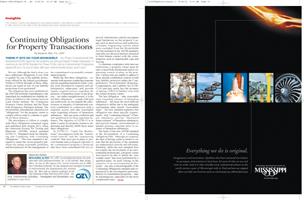
There it sits on your bookshelf – the Phase I Environmental Site Assessment (ESA) report for the property you just purchased. It looks impressive. It conforms to the ASTM Standard for Phase I ESAs, and an Environmental Professional signed off on it. So you’re done with your environmental issues, aren’t you?
Not yet. Although the deal is done, you have additional obligations if you wish to qualify for one of the liability protections offered by the federal government. Failure to follow through on these obligations can result in loss of your liability protections if not performed.
The obligations that were established in the 2002 Brownfields Amendments to the Superfund Act established two liability defenses in addition to the existing Innocent Land Owner defense: the Contiguous Property Owner defense and the Bona Fide Prospective Purchaser defense. The Brownfields Amendments identified six “obligations” for the property owner to comply with in order to continue to qualify for these defenses.
The procedures to follow to comply with these obligations remained vague and undefined until August 2011, when the American Society for Testing and Materials (ASTM) issued standard E2790-11, “Standard Guide for Identifying and Complying with Continuing Obligations.” This new standard is designed to assist the recent property purchaser by setting reasonable guidelines and best practices for the management of the contaminated or potentially contaminated property.
While the first three obligations – cooperate with persons conducting response actions regarding hazardous waste; comply with information requests and administrative subpoenas; and provide legally required notices regarding the presence of hazardous waste on the property – are rather straightforward, it is the last three obligations – comply with land use restrictions; do not impede the effectiveness or integrity of institutional controls established in connection with a response action; and take reasonable steps regarding releases of hazardous substances – that can cause confusion and risk qualification for these important defenses. The objective of E2790-11 is to make it easier for property owners to understand and thereby fulfill these latter three obligations.
In E2790-11, “Land Use Restrictions” encompasses both the “institutional controls” and the “engineering controls” that were put in place to prevent human and ecological exposure to the contaminated property’s chemicals that have been remediated but not removed. Institutional controls encompass legal limitations on the property’s usage such as deed notices and restrictive covenants. Engineering controls, which were excluded from the Brownfields Act but included in the ASTM standard, typically are physical barriers designed to limit human contact with the contamination, such as impermeable caps and fencing.
To maintain compliance with land use restrictions, a property owner must be sure to heed both institutional and/or engineering controls in place on the property. Owners who are unable to adhere to these already-established controls would lose liability protection under the Comprehensive Environmental Response, Compensation, and Liability Act (CERCLA) and may easily face the prospect of sharing CERCLA liability costs with the former property owner.
The last obligation – take reasonable steps regarding releases of hazardous substances – has been the most difficult obligation to define due to the ambiguity surrounding what entails “reasonable steps.” The new standard separates this obligation into three specific requirements: stop “continuing releases” of hazard substances; prevent “threatened future releases” of hazardous substances; and prevent human, environmental or natural resource exposure prior to releases of hazardous substances.
The heart of the new ASTM standard is the development of a Continuing Obligations Plan. Although not required, the idea of having a plan is meant to ensure that the provisions of the standards are implemented correctly and efficiently. Similarly, while the new standard does not require the involvement of an environmental professional, a property owner does need to be able to justify the “reasonable steps” that were performed by a qualified party. As such, relying on the expertise of an environmental professional – one who is knowledgeable of the Continuing Obligations standard and experienced in the investigation and remediation of contaminated properties – may be advantageous, especially for the more complicated cases.

